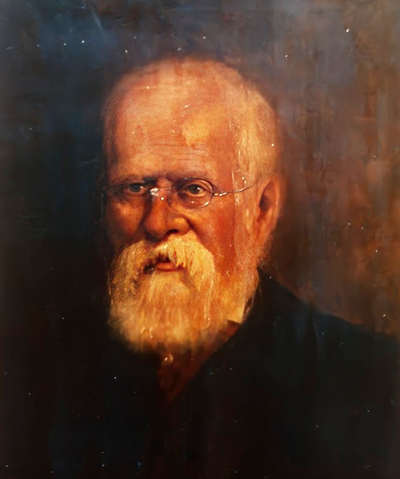
Clissold Park Co-founder John Rüntz
Kindly provided by John Rüntz’s great great grandson William Grant.
—
Early life and family
John Rüntz was born on 20th December 1818. His father was also called John Rüntz and he was born circa 1787; almost certainly in Germany. The family frequently used the umlaut over the ‘u’ and indeed John used it when making his Will in 1889. The use of the umlaut seems to have dropped out of use in later generations.
Rüntz was born at 3 William Street, Kingsland Road, Hackney. He was baptised in the Chapel of the Hoxton Academy, a seminary for training Congregational Ministers; the family were non-conformists. He was brought up in a home with strict moral principles. He married Elizabeth Johnson on 28th May 1841 and at the time of the 1841 Census on 6th June, John and Elizabeth were living with his mother-in-law in Dalston Road, Hackney.
Rüntz had become a Tunbridge Ware[1] manufacturer. Their first son, John Johnson, was born on 14th March 1842. He was followed over the years by 5 more boys; Alfred (1844), Edwin (1849), Arthur (1853), Edgar (1856) and Ernest Augustus (1859). Very sadly Alfred died when he was only 15, Edwin when he was 6, Arthur got to 35 but died before John, and Edgar died before he was 1.
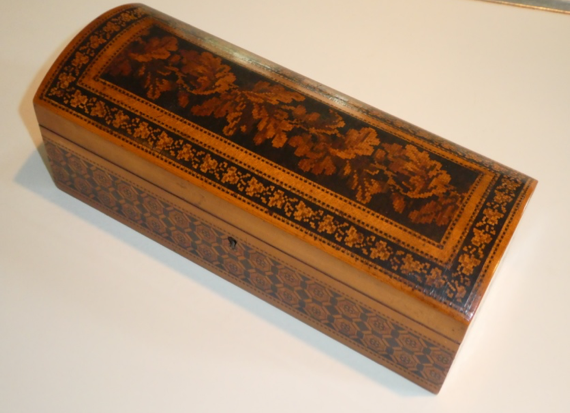
By 1851 the family had moved to Leicester Cottages in Kingsland with the first three children and Elizabeth’s mother. Rüntz had given up making Tunbridge Ware and had become a music teacher. By 1861 they had moved to Milton Road, Hornsey, and then in 1869 they moved to Linton Lodge, Lordship Lane, Stoke Newington.

The Birkbeck Schools
John Rüntz widened his teaching to include other subjects and became particularly interested in helping working class children get an education. He was enlisted by William Ellis to start the Birkbeck Schools which were set up to help children of parents who were ambitious enough to set aside a small amount to pay for their children’s education, slanting their curriculum towards those from artisan and small tradesmen’s homes.
The first school was set up in the London Mechanics Institute in Southampton Buildings near Holborn. The London Mechanics Institute had been set up by Sir George Birkbeck in 1823; it is the same man after whom the present Birkbeck College of London University is named. Because the first school was set up in the Institute they were known as the Birkbeck Schools. Rüntz became the foundation headmaster of the schools.
Pupils were taught not only to read and write but to understand what they were reading and not simply to read by rote. The curriculum was very wide and included human physiology, experimental physics and book-keeping, as well as a host of other subjects. Corporal punishment was not allowed which, bearing in mind the time when the schools were established, is remarkable. Fees in the first school were 12 shillings a quarter and there were optional extras for languages and the piano. A transcription of an advertisement for the Kingsland school in July 1870 is set out in an Appendix to this chapter.
Further schools followed at Finsbury, Vincent Square in Westminster where Rüntz’s brother George became headmaster, Bethnal Green, Peckham and Kingsland where John’s brother James was headmaster for 52 years. Social Science was introduced into the curriculum. Sergeant Major Bertram Browne was the drill instructor. Rüntz became the Superintendent of all the schools.
The Education Act, 1870, introduced state education and gradually over the years the schools closed. Finally, in 1905, the Kingsland Schools were taken over by the London County Council.
Business and the City
In 1847 John Rüntz started a long association with the British Empire Mutual Life Assurance Society. He became Deputy Chairman in 1870 and Chairman in 1873. After a number of mergers the Company is now part of the Phoenix Insurance group.
In 1851 the Birkbeck Building Society was founded under Francis Ravenscroft and in 1852 Rüntz joined the Board. The Building Society was an enormous success; it was so successful that to all intents and purposes it had become a bank. It grew into being the fifth largest deposit taking institution in the country. He attended daily at the Society’s premises and in 1860 became one of its trustees.
In 1868 he became its Chairman. Shortly after he died in 1891 concern arose over the Liberator Building Society as to whether it could repay its depositors. This had a knock on effect on the Birkbeck and there was a run on the Society. This lasted for three days and every depositor who wanted his money back was paid. Nearly £1,000,000 was withdrawn. The Society had a very small capital as opposed to what a Bank would have required so the Society kept a lot of readily cashable securities. Rüntz had run the Birkbeck on sound principles and in the end people realised that the Birbeck was a reliable institution; a great deal of the money which had been withdrawn was redeposited. The only people who lost money were people who withdrew their money and then fell victim to pickpockets outside.
In 1884 he was elected to the Court of Directors of the New River Company[2] and represented the Company on the Lee Conservancy Board[3]. He was also a director of the Gas Purification & Chemical Co. Ltd. and Johnson’s Saccharum Co. Ltd.
He became a freeman of the Worshipful Company of Wheelwrights in 1875, was elected to the Court in 1880 and was Master in 1883/4. He gave the Company two beautiful small gilt dishes.
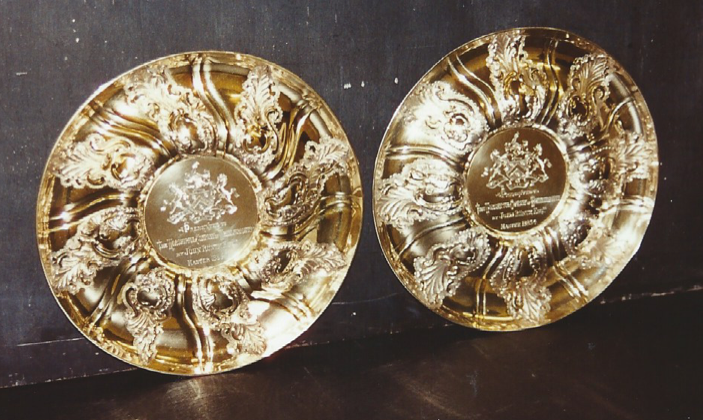
Local Government
In 1842 Rüntz started his long career in Local Government. He was elected to the North Hackney Vestry when he was only 24. He was selected by his colleagues on the Vestry to the North Hackney Board of Works. He was also a member of the Stoke Newington Vestry and from 1867 was the Board’s representative on the Metropolitan Board of Works on which he served for 22 years.
When the Board was replaced by the London County Council in 1889 he stood for election. Just before the election, his son Arthur died unexpectedly, aged 35. His heart was weakened by this loss and he was unable to hold public meetings. He lost by 720 votes.
Rüntz’s main contribution to London was his work to create public open spaces. He was involved in the preservation of Hackney Downs, Mill Hill Fields, Newington Green and Finsbury Park. He was also involved in the freeing of London bridges from tolls. His major work in the creation of public open spaces was with his fellow Common Councillor of the City of London, John Beck. The two men were largely responsible for opening Clissold Park for the public.
Clissold Park
In 1886 Clissold Park was acquired by the acquired by the Ecclesiastical Commissioners for £65,000. A syndicate of builders was prepared to offer the Commissioners £120,000 to purchase the Park. However there was strong support from the local residents to acquire the Park as a public open space and the Commissioners were prepared to offer it to them for £95,000.
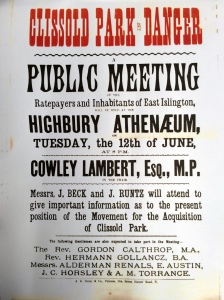
A Private Act of Parliament was required to enable adjoining parishes, aided by the Metropolitan Board of Works and the City Charity Commissioners, to purchase the Park. A group of local residents headed by Joseph Beck, and which included both John Rüntz and his son John Johnson Rüntz, subscribed to a Guarantee Fund for the Bill. Both the Metropolitan Board of Works and the New River Company opposed the Bill but John Rüntz, being involved in both organisations, persuaded them to drop their opposition and the Bill went through both houses of Parliament without opposition.
The purchase money of £95,000 was now required with completion being at Michaelmas and if there was any delay interest would be payable at 4%. The City Corporation, on behalf of the City Charities agreed to subscribe £47,500. The Metropolitan Board of Works agreed to pay £25,000. Stoke Newington agreed £10,000 and South Hornsey £6,000. Hackney voted £5,000 and, with a bit of reluctance, Islington agreed to provide £2,500.
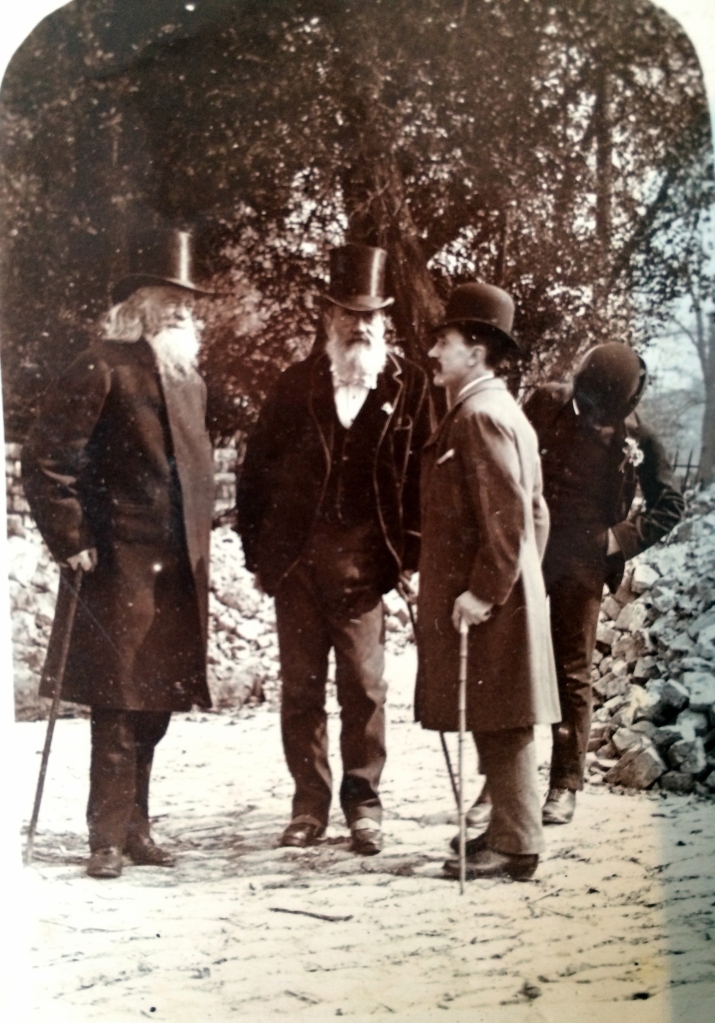
Although this came to £96,000 interest had accumulated for late completion amounting to £5,000. Joseph Beck persuaded the Commissioners to forego the interest and all seemed well, but there was one further snag when the City Charities, for technical legal reasons, were not yet ready to put up their £47,500. This time John Rüntz persuaded the Metropolitan Board of Works to advance the money and on 10th January 1889, when Joseph Beck was in India, he was able to pay into the Bank of England for the account of the Ecclesiastical Commissioners £96,000. Next day Clissold Park became public property and on 24th July 1889 Lord Rosebery, then Chairman of the London County Council and later Prime Minister, opened the Park.
In the Park there are two lakes called respectively Beckmere and Runtzmere and there is a substantial drinking fountain memorial to Joseph Beck and John Rüntz.
Territorial Army
As if all this was not enough, by the time John and his family moved to Linton Lodge in Lordship Lane, he was a Captain in the Stoke Newington Rifles, a Company of the Tower Hamlets Rifle Volunteer Corps. His brother James was a sergeant and the Secretary, and his son Arthur a private. None other than Sergeant-Major Browne was the drill sergeant who was also the drill master of the Birkbeck Schools. In due course the Tower Hamlets Rifle Volunteer Corps was amalgamated with the London Rifle Brigade. He retired from the Brigade in his 54th year.
Death
John Rüntz died on 19th December 1891 and is buried in the Great Northern Cemetery with his wife, Elizabeth, his son Arthur Harry and his wife Maria Ann.
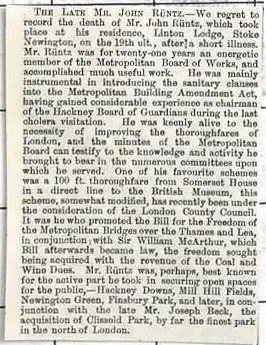
[1] Tunbridge Ware Mosaic is a meticulous process of gluing together different coloured woods so as to make a geometric, floral or pictorial design and then cutting them across the grain to produce repetitions of the same design which can then be glued together onto various surfaces.
[2] The New River Company was founded by Sir Hugh Myddleton in 1609 to construct a water supply for the City of London from Amwell near Ware in Hertfordshire to a reservoir in Clerkenwell, 38 miles away. The Company was incorporated by Royal Charter in 1619. In 1904 it was taken over by the Metropolitan Water Board.
[3] The Lee Conservancy Board was established in 1869 to administer the River Lee Navigation many of its functions are now carried out by the British Waterways Board.